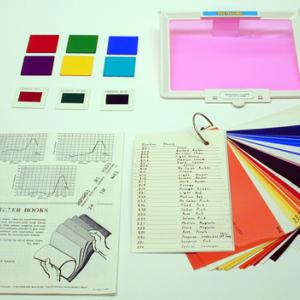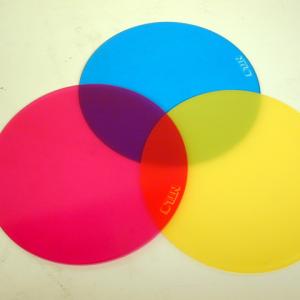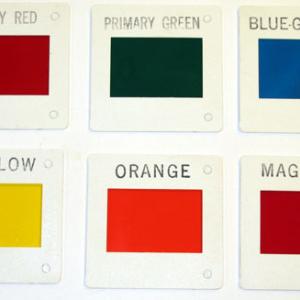College of Liberal Arts & Sciences
6F10.20 - Filters
We have used the filters in conjunction with the photoelectric effect demo (7A10.30) to show that the energy of light greatly affects the amount of radiation detected at the photocell.
In this case the detector is a photocell, but this can be equated to the eyes, radios, solar cells, or any other electromagnetic detector.
The set of three large round filters are Subtractive filters. The disks are cyan, magenta, and yellow. These can be used to show colors as they are used in the printing industry.
- Robert M. Williamson, "Filters for Color Mixing", TPT, Vol. 36, # 1, p. 22, Jan. 1998.
- David Keeports, "When Yellow and Blue Make Red", TPT, Vol. 33, # 7, p. 430, Oct. 1995.
- James C. Kernohan, "Red, White, Blue, and Black", TPT, Vol. 29, # 2, Feb. 1991, p. 113.
- Gordon McComb, "Filters", Lasers, Ray Guns, & Light Cannons, p. 40- 42.
- Janice VanCleave, "Use Colored Filters to Send Secret Messages", Super Science Challenges, p. 132.
- Janice VanCleave, "51, Make a Color", Teaching the Fun of Physics, p. 82.
- Janice VanCleave, "52, Secret Message", Teaching the Fun of Physics, p. 83.
- Jearl Walker, "6.132, Colors of Green Glass and Green Velvet", The Flying Circus of Physics Ed. 2, p. 298.
- Jearl Walker, "6.96, Alexandrite Effect", The Flying Circus of Physics Ed. 2, p. 279.
- John H. Moore, Christopher C. Davis, Michael A. Coplan, "Filters", Building Scientific Apparatus 2nd Edition, p. 164-168.
- T. D. Rossing, C. J. Chiaverina, "Spectral and Monochromatic Filters", Light Science, Physics and Visual Arts, p. 181.
- T. D. Rossing, C. J. Chiaverina, "Multilayer Interference Filters", Light Science, Physics and Visual Arts, p. 113.
Disclaimer: These demonstrations are provided only for illustrative use by persons affiliated with The University of Iowa and only under the direction of a trained instructor or physicist. The University of Iowa is not responsible for demonstrations performed by those using their own equipment or who choose to use this reference material for their own purpose. The demonstrations included here are within the public domain and can be found in materials contained in libraries, bookstores, and through electronic sources. Performing all or any portion of any of these demonstrations, with or without revisions not depicted here entails inherent risks. These risks include, without limitation, bodily injury (and possibly death), including risks to health that may be temporary or permanent and that may exacerbate a pre-existing medical condition; and property loss or damage. Anyone performing any part of these demonstrations, even with revisions, knowingly and voluntarily assumes all risks associated with them.


